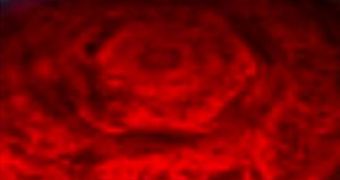By piecing together pictures of Saturn taken by the Voyager 2 spacecraft, David A. Godfrey (National Optical Astronomy Observatories) has discovered an unusual feature in the planet's atmosphere. The mosaics reveal a hexagon centered on the north pole. Since neither probe flew directly over the pole two decades ago, the complete scene had to be created by stretching a series of photographs taken from the side as Saturn rotated, then fitting them into a polar projection.
The strangest fact is that it has also appeared in recent Cassini images, indicating that it is a long-lived feature. A second hexagon, significantly darker than the brighter historical feature, is also visible in the Cassini pictures. The spacecraft's visual and infrared mapping spectrometer is the first instrument to capture the entire hexagon feature in one image.
"This is a very strange feature, lying in a precise geometric fashion with six nearly equally straight sides," said Kevin Baines, atmospheric expert and member of Cassini's visual and infrared mapping spectrometer team at NASA's Jet Propulsion Laboratory, Pasadena, Calif. "We've never seen anything like this on any other planet. Indeed, Saturn's thick atmosphere where circularly-shaped waves and convective cells dominate is perhaps the last place you'd expect to see such a six-sided geometric figure, yet there it is."
The hexagon is similar to Earth's polar vortex, which has winds blowing in a circular pattern around the polar region. On Saturn, the vortex has a hexagonal rather than circular shape. It is nearly 25,000 kilometers (15,000 miles) across.
Nearly four Earths could fit inside it.
The new images taken in thermal-infrared light show the hexagon extends much deeper down into the atmosphere than previously expected, some 100 kilometers (60 miles) below the cloud tops. A system of clouds lies within the hexagon. The clouds appear to be whipping around the hexagon like cars on a racetrack.
The pattern's origin is a matter of much speculation.
Some astronomers seem to favor some sort of standing-wave pattern in the atmosphere, or the hexagon being a new sort of aurora, though both are still controversial issues. More extreme speculations suspect Saturn's radio emissions emanating from the hexagon rather than from the planet's interior.
Some observed similarities between the hexagon and the radial spoke structures sometimes seen in the atmosphere of Venus.
The hexagon appears to have remained fixed with Saturn's rotation rate that is still uncertain.
Scientist hope to get a clue about the actual rotation rate by studying the dynamical nature of the long lived, deep-seated polar hexagon.

 14 DAY TRIAL //
14 DAY TRIAL //